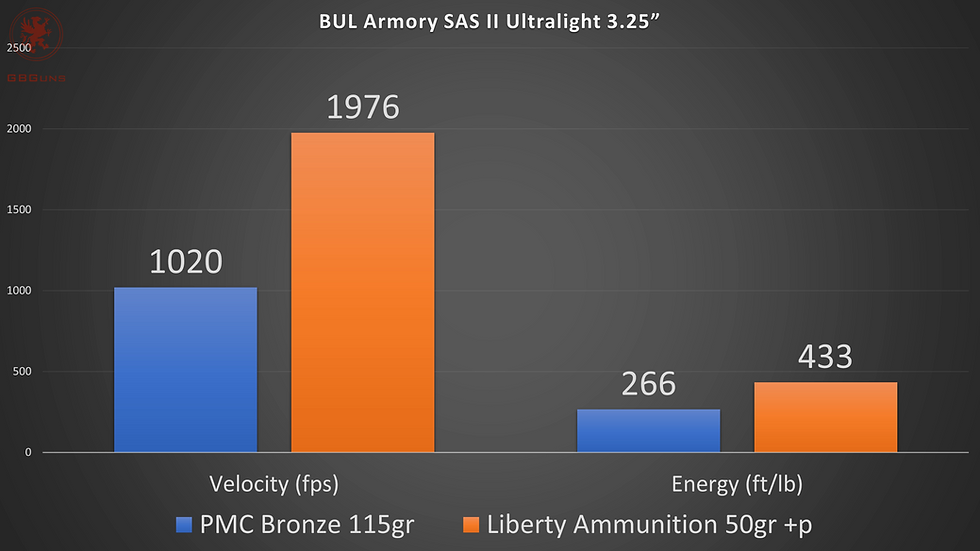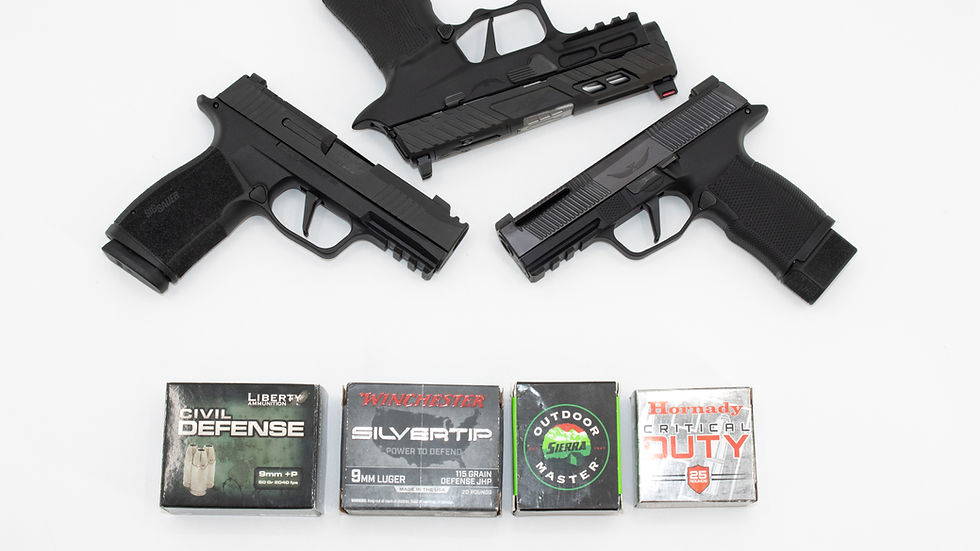Liberty Ammunition Test
- Graham Baates

- Dec 18, 2022
- 6 min read
Updated: Mar 8, 2024
*Some of the external links found on this website are affiliate links. Those links use cookies to generate revenue and fund continuation of this website. By clicking an external link you are consenting to a temporary cookie, by purchasing from that link you are supporting this website. To opt out of cookies do not click external links.

When we tested a few defensive ammunition choices in common carry gun sizes we were really impressed with the numbers we got from Liberty Ammunition's Civil Defense 50gr +P load. Wanting to dive further into that we gathered up some more Liberty Ammunition and a broader selection of common pistol barrel lengths to see just what the difference is. Liberty Ammunition was confident enough in their Civil Defense load to provide their ammunition for testing. The ball ammunition used as a control in this test was provided by our Ammo Squared supporters.
There are plenty of exciting videos demonstrating hollow points, including Liberty's frangible hollow point design already out there and they are always met with the same criticism. If Clear Ballistic's gel is used people complain that it's not a true representation of how the round would perform in flesh. If the much-less temperature stable classic ballistic gelatin is used, then it's hard to really see what the round can do. Meat targets offer some realism and visual entertainment, but are hard to objectively measure results in. That leaves us with the only truly objective test, chronographing.
With the projectile weight known, if we find the speed of the bullet we can then calculate how much energy the projectile has. This is commonly referred to as "muzzle energy" but truly it is how much energy the projectile has at the point where its velocity was measured. For that reason I prefer to place the chronograph at the target. That way we know how much energy the projectile has when it hits the target.
Muzzle energy = bullet mass x bullet velocity 2 / ( 2 x dimensional constant x 7000 )
Don't worry, I don't get that sciencey, there are a number of websites that will calculate for you if you simply know projectile weight in grains and velocity in feet per second.
Test Intent:
1) Determine how much energy Liberty Ammunition's Civil Defense 9mm 50gr +P ammunition delivers to the target.
2) Compare this energy against a standard 115gr load as a control. (PMC Bronze was used as it is a fairly common range ammunition most of us have experienced.)
3) See what impact barrel length has on energy delivered. Remember that generally "+P" overpressure is used to help the bullet make up for shorter barrel lengths (under 4" for 9mm).
Test Concept and Structure:
Chronograph, then average five shots of each ammunition type through each pistol.
Popular barrel lengths chosen and one significantly-longer barrel to represent large-format pistols.

Ammunition Used:
Chronograph:
Firearms Used in Test:
Sig P365 X Macro: 3.1 barrel equates to the P365, Springfield Hellcat, and many popular single-stack 9mm pistols such as the S&W Shield.
BUL Armory SAS II Ultralight: 3.25" barrel is only slightly longer than a 3.1", does that make a difference?
Sig P365 XL: 3.7" barrel is quickly becoming the replacement of yesterday's 4" sizing. This barrel length is also used on the Springfield Hellcat PRO.
Tisas USA PX-9 Gen 3 Duty: 4" barrel has long been considered the standard size for a 9mm pistol and is the length SAAMI uses for ammunition design.
Grand Power X-Calibur: 5" barrel was long the preferred length for competition shooters and is the longest common barrel for a 9mm pistol.
Century Arms Draco 9S: The 11.14" barrel is generally considered around the maximum length before friction on the barrel begins to slow a projectile. The Draco 9S in this test serves as an example of a large-format pistol that is not a carbine.
Results:
This was interesting. I mulled over how to present this information in a way that was both digestible and interesting. It's important to realize that the numbers you see on a box of ammunition may not be numbers you ever experience. Barrel length, air and ammunition temperature, and altitude all play a role in velocity. If a company only creates their statistics in Denver, Colorado during the summer using a test barrel chances are what you'll experience at home will be quite different. This test was conducted at 300' elevation (the lower you go the denser the air is and slower bullets fly) and with an outside temperature of 28 degrees Fahrenheit (cooler air is denser = slower bullets. Colder powder also produces lower velocities).
Results below are broken down by firearm platform as well as any notes.
3.1" Barrel (Sig P365, P365 X Macro, Springfield Hellcat, etc)

Because the Sig P365 X Macro was used I was able to experience how the compensator is impacted by what assumably is increased gas from the Liberty +P round. I found the pistol shot considerably softer with the Liberty +P ammunition than it did with standard-pressure PMC Bronze. More gasses hitting the compensator = more compensation effect! Point of impact was about the same with both loads, and this was the loosest group for both loads.
277 foot-pounds of energy from a 9mm pistol sure sounds weak, but the Liberty Ammunition's speed was able to bring the stubby 3.1" barrel back up into a level of energy that I would be comfortable delivering to stop a threat.
3.25" Barrel (BUL Armory SAS II Ultralight used)

Despite the slightly longer barrel we got slightly less velocity from both loads. This could be contributed to a variety of factors (including poor sampling), but it likely a result of the BUL Armory barrel possibly being tighter in the bore than the mass-produced Sig barrel. I don't know for sure. Felt recoil for this pistol was higher for the Liberty Ammunition than it was for the PMC Bronze.
3.7" Barrel (Sig P365XL and similar)

With "big" micro-compacts becoming more common this was an interesting one to see. The gain over the 3.1" barrel was more impressive for the Liberty Ammunition than it was for the standard ball. A strong fact that not all ammunition is the same, and yet another reason why our What's For Dinner™ Test includes so many loads.
4.0" Barrel (Tisas USA PX-9 Gen 3 Duty)

The 4" barrel has long been considered the standard for a 9mm. So much so that SAAMI (Sporting Arms and Ammunition Manufacturer's Institute) defines it as the test-barrel length 9mm ammunition is to be manufactured for. The ubiquitous Glock 19 and many other popular guns use this barrel length. Short enough to carry, long enough to be enjoyable on the range. Though not a barrel length that +P ammunition is usually intended for, Liberty Ammunition still enjoyed a 58% gain in energy over our 115gr control load.
5.0" Barrel (Grand Power X-Calibur)

When I competed it sure felt like steel targets knocked down quicker when shot by longer barrels. It's not just a feeling, it's a fact! The standard ball ammunition enjoyed an 11% increase over the 4" barrel and Liberty Ammunition gained about 11% as well. More power, a smoother recoil impulse, and longer sight radius are all reasons why 5" guns are a blast to shoot. Note that at this barrel length Liberty Ammunition's 9mm energy is in the neighborhood of what is considered the norm for 10mm. This does make you wonder though; what happens when we push that barrel out more than twice this length?
11.14" Barrel (Century Arms Draco 9S)

More than double the barrel length of the Grand Power X-Calibur and a modest gain in velocity and energy. A 16% gain for the 115gr and 25% gain for Liberty Ammunition. 654 foot-pounds of energy from the Liberty Ammunition load is no joke. That's more than double what we got with standard 115gr ammunition in the smaller pistols. The Civil Defense load effectively replicates 10mm power at this point, but is a smaller, lighter, less-expensive package.
All combined

Looking at it this way it's pretty clear that Liberty Ammunition's Civil Defense delivers more energy. In fact, at no point in our testing did the standard 115gr load beat Liberty Ammunition, even the 11.14" barrel Draco 9S is weaker with 115gr than a tiny 3.1" P365 loaded with Liberty Ammunition.
Another way to look at the test results is to see what percentage the Liberty Ammunition Civil Defense round increases energy over a standard load.

Across all six barrel lengths tested, the Liberty Ammunition Civil Defense load hit harder by a considerable percentage. At the range we just want to make noise and hit targets, but in a self-defense situation energy transfer is the entire point of a shot.









I’m a mathematician at heart and the numbers never lie. If you are punched by a 300# guy then by a 600# guy, you will definitely feel the difference. Enough to disrupt the “attack” and allow you more options for follow-up shots/actions. Remember every plan falls apart when you get punched.
Okay, so I'm still confused LoL! I've always taught my LTC classes that I'm really a sucker for new ammunition. And I'll usually buy a box just to have fun with it and shoot it. But I stick with what I know works. Energy is an objective measurement, that's true and very useful - all things being equal. But they're not equal here. Physics dictates that projectiles of the same diameter and size traveling the same speed will penetrate a given consistent medium to the same depth. If two projectiles of identical diameter and size are traveling the same speed, but one is 2.3x heavier than the other, then the heavier projectile will penetrate deeper into that same, consistent medium.…